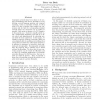Free Online Productivity Tools
i2Speak
i2Symbol
i2OCR
iTex2Img
iWeb2Print
iWeb2Shot
i2Type
iPdf2Split
iPdf2Merge
i2Bopomofo
i2Arabic
i2Style
i2Image
i2PDF
iLatex2Rtf
Sci2ools
AAAI
1992
1992
On the Minimality and Decomposability of Constraint Networks
Constraint networks have been shown to be useful in formulating such diverse problems as scene labeling, natural language parsing, and temporal reasoning. Given a constraint network, we often wish to (i) nd a solution that satis es the constraints and (ii) nd the corresponding minimal network where the constraints are as explicit as possible. Both tasks are known to be NP-complete in the general case. Task (i) is usually solved using a backtracking algorithm, and task (ii) is often solved only approximately by enforcing various levels of local consistency. In this paper, we identify a property of binary constraints called row convexity and show its usefulness in deciding when a form of local consistency called path consistency is su cient to guarantee a network is both minimal and decomposable. Decomposable networks have the property that a solution can be found without backtracking. We show that the row convexity property can be tested for e ciently and we show, by examining applicat...
| Added | 06 Nov 2010 |
| Updated | 06 Nov 2010 |
| Type | Conference |
| Year | 1992 |
| Where | AAAI |
| Authors | Peter van Beek |
Comments (0)

